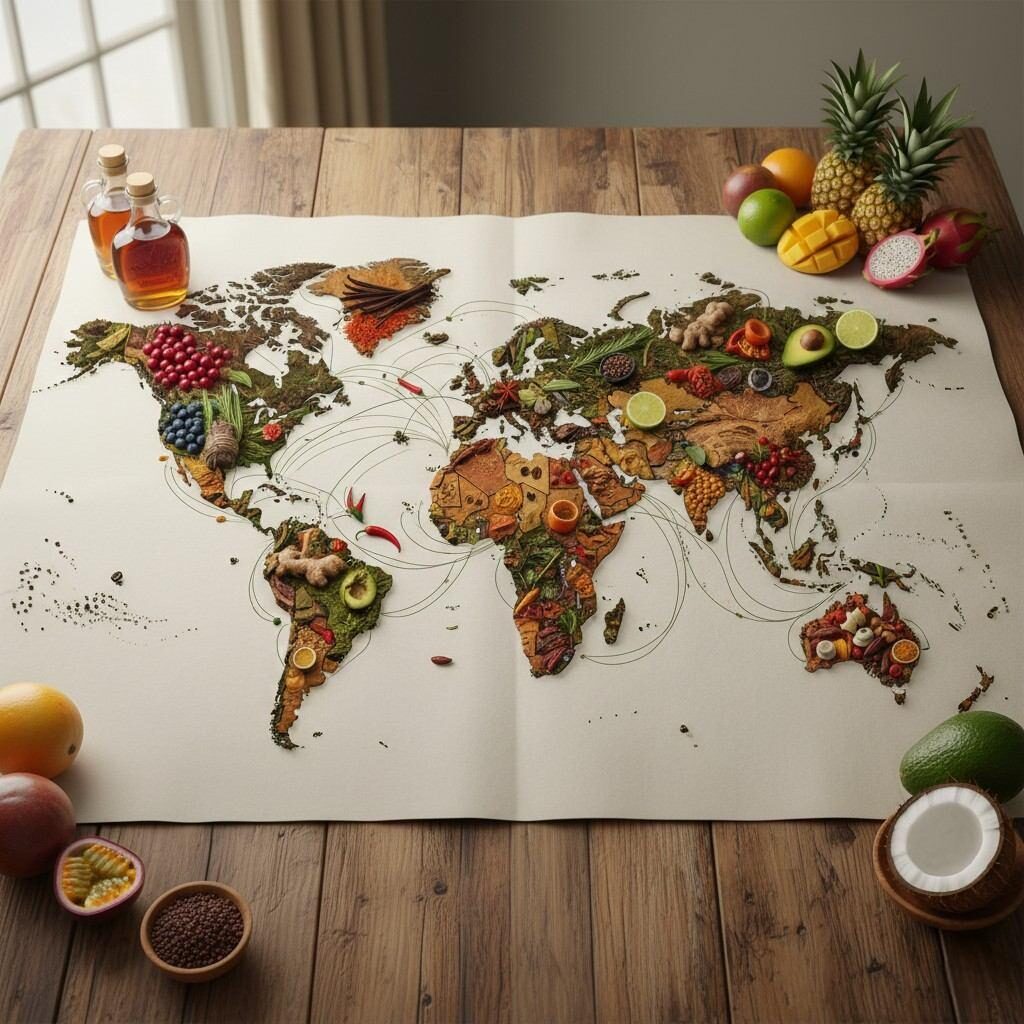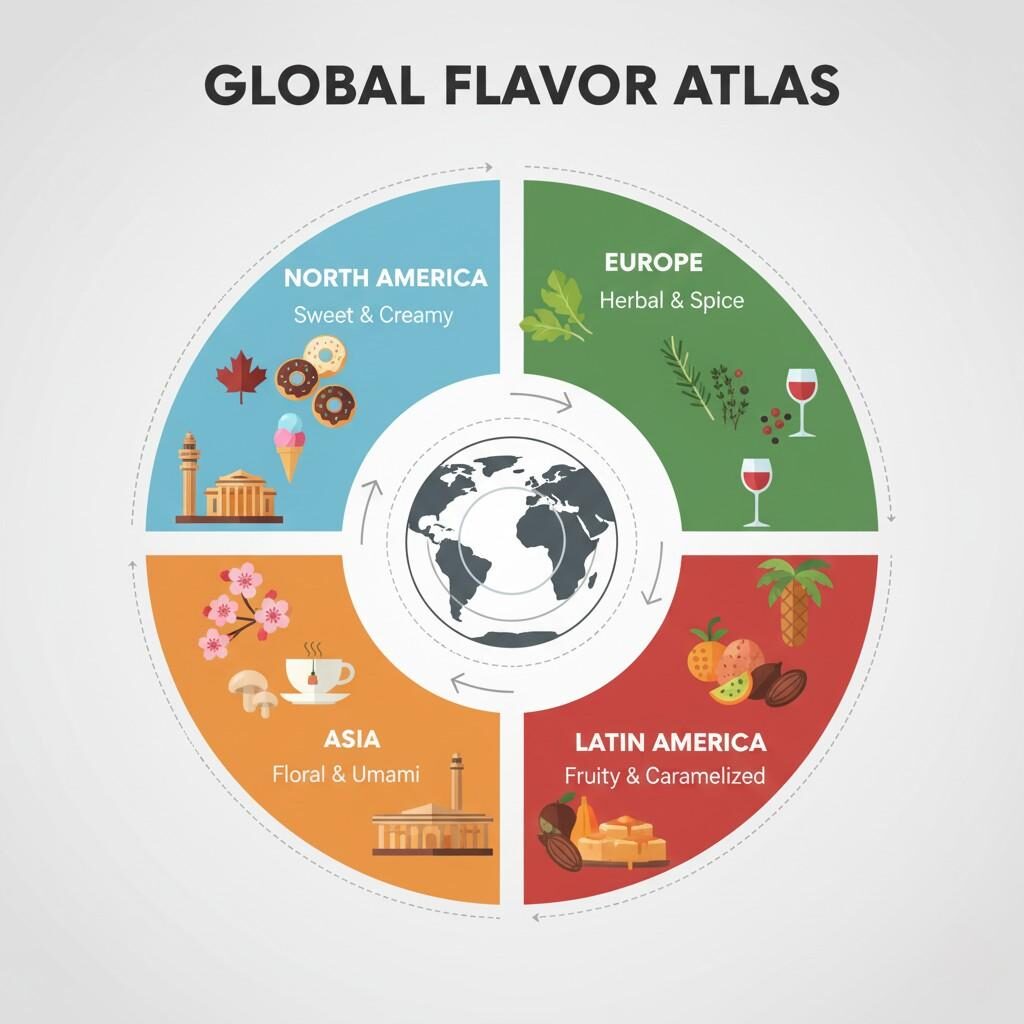Author: R&D Team, CUIGUAI Flavoring
Published by: Guangdong Unique Flavor Co., Ltd.
Last Updated: Oct 20, 2025

Global Flavor Map
In today’s rapidly evolving food and beverage industry, consumer taste preferences are no longer confined by borders. The modern palate seeks exploration — a sensory journey that combines the comforting familiarity of local traditions with the excitement of global culinary influences. This evolution has given rise to what experts call “global flavor fusion” — a data-driven, cross-cultural approach to flavor development that blends ingredients, aromas, and taste profiles from different regions to create products that resonate internationally.
According to a report by the Food and Agriculture Organization (FAO), the global demand for flavor innovation is increasing as international trade and travel shape more complex consumer preferences [¹]. Multinational food brands and beverage companies now see flavor fusion as a strategic pathway to diversification, competitive differentiation, and higher market acceptance across regions.
For flavor manufacturers and R&D teams, this trend means one thing: mastering the art and science of cross-cultural flavor synthesis is essential to staying relevant in the next generation of product innovation.
“Global flavor fusion” is more than simply mixing ingredients from different cuisines. It represents a systematic approach — guided by sensory science, market analytics, and cultural insight — to create harmonized flavor systems that appeal to diverse consumers while maintaining technical stability in various product matrices.
At its core, flavor fusion involves:
As described in the Institute of Food Technologists (IFT) Journal, global flavor innovation now requires multidisciplinary collaboration between food scientists, flavorists, cultural researchers, and sensory analysts [²]. Successful companies translate culinary inspiration into scalable, compliant formulations through data-driven sensory design.

Global Market Drivers Infographic
Over the past two decades, increased global travel and migration have exposed consumers to new taste experiences. Travelers returning home crave the flavors they encountered abroad — from Korean gochujang sauces to Mexican tamarind beverages. This creates cross-cultural flavor demand, influencing product development in mainstream food and beverage markets.
Platforms such as TikTok, Instagram, and YouTube have transformed global food exploration into a social movement. Viral recipes and influencer-led “taste challenges” introduce consumers to exotic flavors in real time, accelerating flavor trend diffusion. For instance, the sudden global popularity of dalgona coffee and Japanese matcha desserts demonstrates how quickly flavor fusion trends can evolve from local to global phenomena.
Urban centers are becoming increasingly multicultural. According to the U.S. Census Bureau, over 44% of millennials in the United States identify with multiple ethnic backgrounds [³]. This demographic shift naturally expands the demand for hybrid cuisines and fusion beverages that reflect blended cultural identities.
Improved logistics and ingredient standardization allow flavor houses to source authentic raw materials — such as Peruvian cacao, Thai lemongrass oil, or Turkish rose essence — with greater consistency. This accessibility enhances authentic global replication in industrial flavor design.
Successful global flavor fusion requires precision in aroma layering. In professional flavor design, this involves structuring volatile compounds into sensory tiers:
| Layer | Function | Example Compound Type | Example Fusion Application |
| Top Notes | Initial aroma impact | Aldehydes, esters | Citrus zest in Asian-lime sorbet |
| Heart Notes | Flavor identity & harmony | Lactones, ketones | Creamy vanilla–matcha latte |
| Base Notes | Lingering aftertaste | Pyrazines, phenols | Smoked cocoa–chili chocolate bar |
Through GC–MS (Gas Chromatography–Mass Spectrometry) profiling, formulators can quantify and align these components to create consistent cross-cultural flavor blends.
Flavor scientists use palate mapping models to identify cultural taste preferences. For example:
By integrating AI-driven sensory data with human tasting panels, R&D teams can predict optimal fusion combinations — such as yuzu-ginger lemonade or mango-rose lassi drinks — that perform well across multiple regions.
The challenge of fusion flavor design lies not only in sensory harmony but also chemical compatibility. Factors like pH sensitivity, temperature stability, and fat solubility influence whether certain compounds remain stable in beverages, dairy, or confectionery systems.
For instance:
Therefore, flavorists must integrate both creative innovation and process engineering to ensure consistent performance from lab to large-scale production.

Global Flavor Atlas
Asia’s culinary diversity provides abundant inspiration for fusion design:
Asian flavors’ rising global influence drives innovation in teas, energy drinks, and non-alcoholic cocktails, emphasizing natural and functional ingredients.
European flavor heritage contributes depth and sophistication:
The fusion of European herbal refinement with global exotic profiles offers premium appeal for modern product lines.
From Latin America’s mango-chili combinations to North America’s bourbon caramel notes, Western consumers gravitate toward intense and nostalgic flavors. These pair effectively with subtle Asian or Middle Eastern nuances — such as chili-coconut fusion or coffee-cardamom blends.
Middle Eastern flavor traditions — such as rose, saffron, and cardamom — have expanded into the global beverage scene, while African ingredients like baobab and hibiscus are emerging as functional superfood components. Combining these with citrus or tropical notes creates globally relevant flavor hybrids.
Beverages serve as the fastest channel for flavor experimentation due to lower formulation barriers and rapid consumer feedback cycles.
Examples of successful fusion concepts include:
Flavor manufacturers now use natural extracts, encapsulated emulsions, and fermentation-derived notes to enhance sensory complexity while maintaining clean-label compliance.
Global consumers increasingly appreciate fusion desserts such as matcha tiramisu, rose-flavored chocolates, and mango-coconut cheesecakes.
Formulating such products requires balancing sweetness with aromatic contrast — a hallmark of successful sensory integration.
In savory foods, East-meets-West combinations such as miso-butter sauces, curry-infused dips, or truffle-chili marinades demonstrate how fusion flavors redefine gourmet experiences. The use of umami-enhancing amino acid blends provides depth and persistence, essential for culinary authenticity.
Modern flavor development leverages AI-powered sensory analytics to predict cross-cultural success rates. Machine learning models analyze consumer feedback, regional purchasing data, and flavor molecule interactions to identify optimal fusion directions.
A study by Food Business News reported that companies adopting predictive analytics in flavor R&D achieved 30–40% faster market adaptation cycles [⁴].
To protect volatile compounds and ensure stability during processing, microencapsulation and spray-drying technologies are commonly used. Controlled release ensures that the aroma profile remains intact through pasteurization or baking, critical for complex fusion flavors involving delicate floral or fruit notes.
Modern consumers value transparency. Therefore, fusion flavors must align with natural ingredient standards, allergen-free labeling, and regional compliance (e.g., FDA, EFSA, GB) requirements. Manufacturers that integrate global compliance expertise gain an advantage in entering multiple markets simultaneously.
To scale global flavor fusion across product categories, manufacturers should follow a structured approach:
This process transforms inspiration into a commercially viable flavor pipeline.
Consider a beverage manufacturer aiming to introduce a “Tropical Harmony” line that merges Caribbean pineapple with Japanese yuzu and French vanilla.
This demonstrates how technical formulation precision and cultural insight create global success stories.

Digital Flavor R&D
The next decade will see AI-assisted flavor creation, bioengineered aroma molecules, and personalized taste algorithms transforming how fusion flavors are conceived.
As biotechnology enables natural compound synthesis and sustainability becomes central to consumer preference, global fusion design will merge innovation with eco-conscious production — a perfect alignment of technology, taste, and responsibility.
In an interconnected marketplace, global flavor fusion represents more than an innovation trend — it is a philosophy that reflects how cultures, technologies, and tastes converge.
At CUIGUAI Flavoring, we specialize in high-quality food and beverage flavor systems, engineered through advanced GC–MS analysis, cross-cultural sensory design, and sustainable ingredient sourcing. Our R&D team collaborates globally to craft flavor profiles that inspire both familiarity and discovery — the essence of modern product innovation.
Contact our flavor experts for technical consultation, sample requests, or custom flavor development designed for your next global product line.
📩 Request a Free Sample / Technical Exchange
📩 [info@cuiguai.com]
📞 [+86 189 2926 7983]
🌐 Explore more at 【www.cuiguai.cn】
[¹] Food and Agriculture Organization of the United Nations (FAO). Food Outlook: Global Market Analysis. 2024.
[²] Institute of Food Technologists (IFT). Journal of Food Science, Vol. 89, Issue 4, 2024.
[³] U.S. Census Bureau. Demographic Trends Report 2023.
[⁴] Food Business News. Predictive Analytics Reshape Flavor Innovation, 2024.
Copyright © 2025 Guangdong Unique Flavor Co., Ltd. All Rights Reserved.